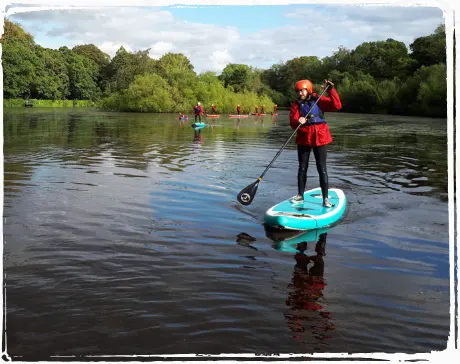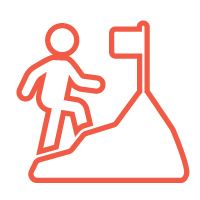put your balance to the test
As one of the fastest growing water sports in the UK. Paddling on your stomach, knees, and feet, stand up paddle boarding (SUP) provides an endless amount of fun on the water for students of all ages and abilities.
Students on adventure with us get to paddle across calm reservoir waters in the Yorkshire Dales and North York Moors National Parks.
Enjoy our single SUPs at Bewerley park or Jumbo SUP at East Barnby.
Paddle boarding is a seasonal activity and is available from the Easter holidays to the October Half Term.
What’s Included

All specialist equipment
Stand up paddleboard, paddles, buoyancy aid, and watersports helmet.
All specialist clothing
Wetsuit and waterproofs when required.
Transport
Once at the centre, all transport to and from adventure activities is provided.
Experienced, full-time, outdoor teachers and tutors
Each group of 12 students is led by a fully qualified and experienced outdoor tutor.
– back in the classroom –
curriculum links
Not only is paddleboarding a booming sport with great appeal it can be used as an exciting way to explore and meet areas of the curriculum, water safety is inherently important as a part paddleboarding, learning safe use of the craft and managing personal safety on the water is key. Engaging with the environment on the water cycle or the areas history can also form key aspects of the activity.
Key Stage 2
P.E: Water Safety
Students will learn all about the risks and dangers that are present in the environment, how to assess and manage the risks, and how to keep themselves safe.
Geography: Water Cycle
Students will see the water cycle in action. They can discuss how water moves around the world and ultimately ends up where they are. Other aspects can also be discussed such as where drinking water comes from and how it is processed.
Key Stage 3
Design and Technology
Paddleboarders can learn all about the design of the boards and how materials have developed over time, with rigid and inflatable models. They can also learn how balance and trim effects the performance of the craft.
History: Local
Local history around the uses of the waterways by people, now and in the past, can be explored in detail. Discussion can be had around what the areas close to the waterway were used for and how this has changed over time.
Key Stage 4
P.E.
Following the GCSE P.E. curriculum, we can help develop students’ skills to help them perform core paddling skills/techniques in increasingly demanding and progressive drills in interesting and fun environments.
Geography
The challenge of natural hazards is part of the GCSE curriculum. Whilst paddling, students can spend time talking about these hazards and exploring how they have shaped the environment.
When paddling down a river, students can observe how the shape of the valley changes as the river flows downstream. If paddling on reservoir waters, the use of the water and the impact of the reservoir’s construction can be discussed and explored.
LOCATIONS: Offered at both Bewerley Park and East Barnby
YEAR GROUPS: Suitable for Primary School, Secondary School, and post 16 students

DURATION: Available as a full or half day activity

DIFFICULTY: Adapted to the age and level of experience of students on adventure
MIN GROUP SIZE: 12 Students
put your balance to the test
As one of the fastest growing water sports in the UK. Paddling on your stomach, knees, and feet, stand up paddleboarding provides an endless amount of fun on the water for students of all ages and abilities.
Students on adventure with us get to paddle across calm reservoir waters in the Yorkshire Dales and North York Moors National Parks.
What’s Included?
All specialist equipment
Stand up paddle board, paddles, buoyancy aid, and watersports helmet
All specialist clothing
Waterproofs and wetsuits when required.
Transport
Once at the centre, all transport to and from adventure activities is provided.
Experienced, full-time, outdoor teachers and tutors
Each group of 12 students is led by a fully qualified and experienced outdoor tutor.
classroom benefits
curriculum links
Not only is paddleboarding a booming sport with great appeal it can be used as an exciting way to explore and meet areas of the curriculum, water safety is inherently important as a part paddleboarding, learning safe use of the craft and managing personal safety on the water is key. Engaging with the environment on the water cycle or the areas history can also form key aspects of the activity.
Key Stage 2
P.E. Water Safety
Students will learn all about the risks and dangers that are present in the environment, how to assess and manage the risks, and how to keep themselves safe.
Geography: Water Cycle
Students will see the water cycle in action. They can discuss how water moves around the world and ultimately ends up where they are. Other aspects can also be discussed such as where drinking water comes from and how it is processed.
Key Stage 3
Design and Technology
Paddleboarders can learn all about the design of the boards and how materials have developed over time with rigid and inflatable models. They can also learn how balance and trim effects the performance of the craft.
History: Local
Local history around the uses of the waterways by people, now and in the past, can be explored in detail. Discussion can be had around what the areas close to the waterway were used for and how this has changed over time.
Key Stage 4
P.E.
Following the GCSE P.E curriculum, we can help develop students’ skills to help them perform core paddling skills/techniques in increasingly demanding and progressive drills in interesting and fun environments.
Geography
The challenge of natural hazards is part of the GCSE curriculum. Whilst paddling, students can spend time talking about these hazards and exploring how they have shaped the environment.
When paddling down a river, students can observe how the shape of the valley changes as the river flows downstream. If paddling on reservoir waters, the use of the water and the impact of the reservoir’s construction can be discussed and explored.